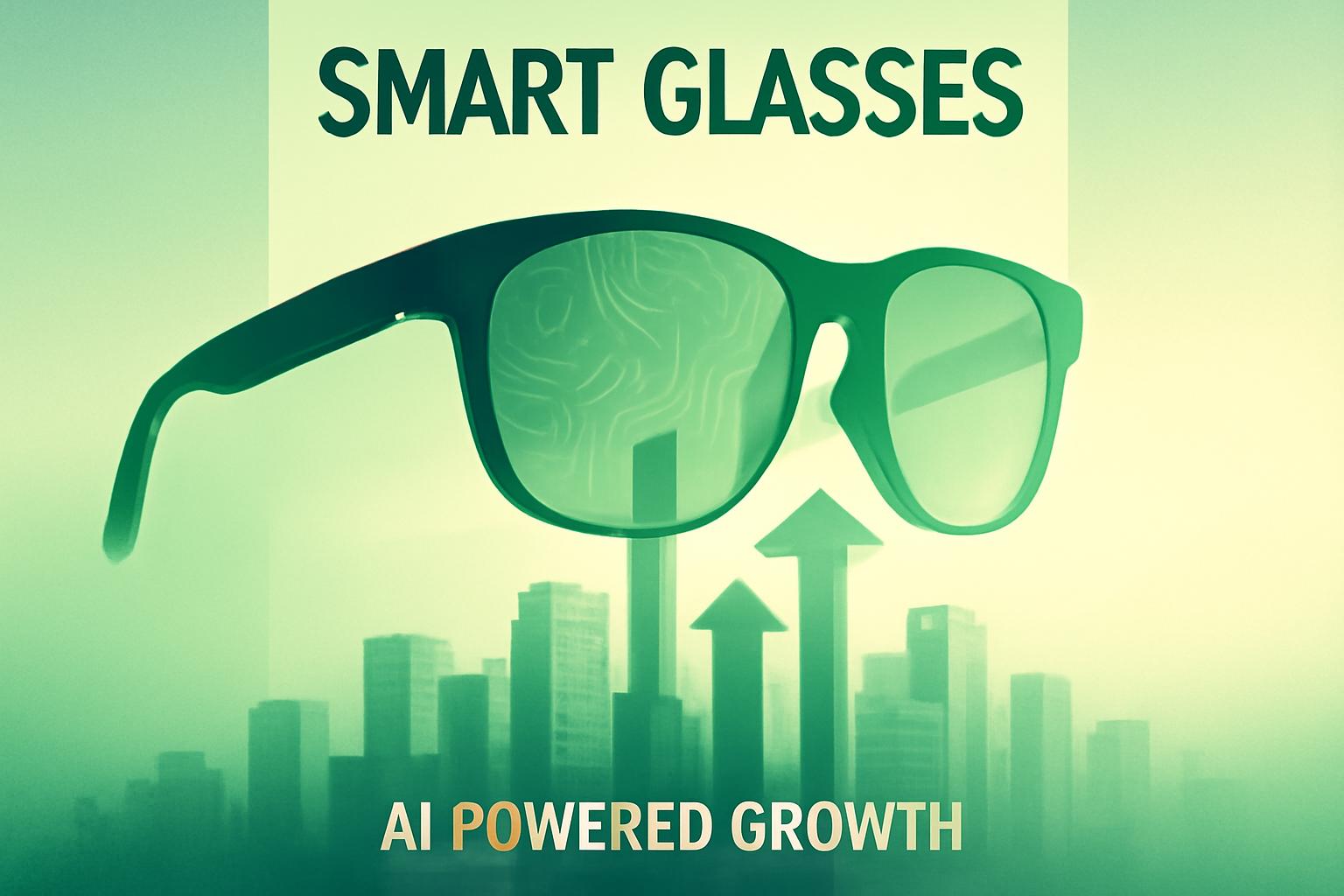EssilorLuxottica’s latest earnings underscore the growing traction of AI-powered smart glasses as a significant revenue driver. The company’s strong partnership with Meta and expansion into multiple luxury eyewear brands position it well in the competitive wearables market. !-- wp:paragraph -->
Contents
FinOracleAI — Market ViewSmart Glasses Market Intensifies with Tech Giants’ EntryFinOracleAI — Market ViewSmart Glasses Market Intensifies with Tech Giants’ EntryFinOracleAI — Market ViewSmart Glasses Market Intensifies with Tech Giants’ EntryFinOracleAI — Market ViewOptimism for Accelerated Production and Revenue StreamsSmart Glasses Market Intensifies with Tech Giants’ EntryFinOracleAI — Market ViewOptimism for Accelerated Production and Revenue StreamsSmart Glasses Market Intensifies with Tech Giants’ EntryFinOracleAI — Market ViewWearables Positioned as Future Computing DevicesOptimism for Accelerated Production and Revenue StreamsSmart Glasses Market Intensifies with Tech Giants’ EntryFinOracleAI — Market ViewWearables Positioned as Future Computing DevicesOptimism for Accelerated Production and Revenue StreamsSmart Glasses Market Intensifies with Tech Giants’ EntryFinOracleAI — Market ViewExpanding Partnership with Meta and Brand DiversificationWearables Positioned as Future Computing DevicesOptimism for Accelerated Production and Revenue StreamsSmart Glasses Market Intensifies with Tech Giants’ EntryFinOracleAI — Market ViewExpanding Partnership with Meta and Brand DiversificationWearables Positioned as Future Computing DevicesOptimism for Accelerated Production and Revenue StreamsSmart Glasses Market Intensifies with Tech Giants’ EntryFinOracleAI — Market ViewEssilorLuxottica Reports Strong Q3 Revenue Growth Fueled by Smart GlassesExpanding Partnership with Meta and Brand DiversificationWearables Positioned as Future Computing DevicesOptimism for Accelerated Production and Revenue StreamsSmart Glasses Market Intensifies with Tech Giants’ EntryFinOracleAI — Market View
- Opportunities: Accelerated production capacity, expanding product portfolio, increasing adoption of AI-enabled wearables, and new revenue streams from lenses and services.
- Risks: Intense competition from tech giants, potential supply chain challenges, and market adoption uncertainties for new smart glasses models.
FinOracleAI — Market View
EssilorLuxottica’s latest earnings underscore the growing traction of AI-powered smart glasses as a significant revenue driver. The company’s strong partnership with Meta and expansion into multiple luxury eyewear brands position it well in the competitive wearables market. !-- wp:paragraph -->- Opportunities: Accelerated production capacity, expanding product portfolio, increasing adoption of AI-enabled wearables, and new revenue streams from lenses and services.
- Risks: Intense competition from tech giants, potential supply chain challenges, and market adoption uncertainties for new smart glasses models.
Smart Glasses Market Intensifies with Tech Giants’ Entry
Meta is not alone in the smart glasses race. Alphabet has invested $150 million in a partnership with Warby Parker to develop glasses powered by Google’s Gemini AI assistant. China’s Alibaba launched smart glasses featuring its Quark AI assistant, while Apple and OpenAI are reportedly developing similar products. !-- wp:paragraph -->FinOracleAI — Market View
EssilorLuxottica’s latest earnings underscore the growing traction of AI-powered smart glasses as a significant revenue driver. The company’s strong partnership with Meta and expansion into multiple luxury eyewear brands position it well in the competitive wearables market. !-- wp:paragraph -->- Opportunities: Accelerated production capacity, expanding product portfolio, increasing adoption of AI-enabled wearables, and new revenue streams from lenses and services.
- Risks: Intense competition from tech giants, potential supply chain challenges, and market adoption uncertainties for new smart glasses models.
Smart Glasses Market Intensifies with Tech Giants’ Entry
Meta is not alone in the smart glasses race. Alphabet has invested $150 million in a partnership with Warby Parker to develop glasses powered by Google’s Gemini AI assistant. China’s Alibaba launched smart glasses featuring its Quark AI assistant, while Apple and OpenAI are reportedly developing similar products. !-- wp:paragraph -->FinOracleAI — Market View
EssilorLuxottica’s latest earnings underscore the growing traction of AI-powered smart glasses as a significant revenue driver. The company’s strong partnership with Meta and expansion into multiple luxury eyewear brands position it well in the competitive wearables market. !-- wp:paragraph -->- Opportunities: Accelerated production capacity, expanding product portfolio, increasing adoption of AI-enabled wearables, and new revenue streams from lenses and services.
- Risks: Intense competition from tech giants, potential supply chain challenges, and market adoption uncertainties for new smart glasses models.
Smart Glasses Market Intensifies with Tech Giants’ Entry
Meta is not alone in the smart glasses race. Alphabet has invested $150 million in a partnership with Warby Parker to develop glasses powered by Google’s Gemini AI assistant. China’s Alibaba launched smart glasses featuring its Quark AI assistant, while Apple and OpenAI are reportedly developing similar products. !-- wp:paragraph -->FinOracleAI — Market View
EssilorLuxottica’s latest earnings underscore the growing traction of AI-powered smart glasses as a significant revenue driver. The company’s strong partnership with Meta and expansion into multiple luxury eyewear brands position it well in the competitive wearables market. !-- wp:paragraph -->- Opportunities: Accelerated production capacity, expanding product portfolio, increasing adoption of AI-enabled wearables, and new revenue streams from lenses and services.
- Risks: Intense competition from tech giants, potential supply chain challenges, and market adoption uncertainties for new smart glasses models.
Optimism for Accelerated Production and Revenue Streams
Grassi expressed optimism about surpassing the originally planned 10 million unit production capacity by the end of 2026 ahead of schedule, driven by strong demand. !-- wp:paragraph --> He also highlighted that the wearable ecosystem will generate not only hardware sales but also increased revenues from lenses and AI-powered services, signaling a multi-faceted growth trajectory. !-- wp:paragraph --> Despite tariff-related price increases, North American sales growth was primarily driven by Ray-Ban Meta smart glasses. !-- wp:paragraph -->Smart Glasses Market Intensifies with Tech Giants’ Entry
Meta is not alone in the smart glasses race. Alphabet has invested $150 million in a partnership with Warby Parker to develop glasses powered by Google’s Gemini AI assistant. China’s Alibaba launched smart glasses featuring its Quark AI assistant, while Apple and OpenAI are reportedly developing similar products. !-- wp:paragraph -->FinOracleAI — Market View
EssilorLuxottica’s latest earnings underscore the growing traction of AI-powered smart glasses as a significant revenue driver. The company’s strong partnership with Meta and expansion into multiple luxury eyewear brands position it well in the competitive wearables market. !-- wp:paragraph -->- Opportunities: Accelerated production capacity, expanding product portfolio, increasing adoption of AI-enabled wearables, and new revenue streams from lenses and services.
- Risks: Intense competition from tech giants, potential supply chain challenges, and market adoption uncertainties for new smart glasses models.
Optimism for Accelerated Production and Revenue Streams
Grassi expressed optimism about surpassing the originally planned 10 million unit production capacity by the end of 2026 ahead of schedule, driven by strong demand. !-- wp:paragraph --> He also highlighted that the wearable ecosystem will generate not only hardware sales but also increased revenues from lenses and AI-powered services, signaling a multi-faceted growth trajectory. !-- wp:paragraph --> Despite tariff-related price increases, North American sales growth was primarily driven by Ray-Ban Meta smart glasses. !-- wp:paragraph -->Smart Glasses Market Intensifies with Tech Giants’ Entry
Meta is not alone in the smart glasses race. Alphabet has invested $150 million in a partnership with Warby Parker to develop glasses powered by Google’s Gemini AI assistant. China’s Alibaba launched smart glasses featuring its Quark AI assistant, while Apple and OpenAI are reportedly developing similar products. !-- wp:paragraph -->FinOracleAI — Market View
EssilorLuxottica’s latest earnings underscore the growing traction of AI-powered smart glasses as a significant revenue driver. The company’s strong partnership with Meta and expansion into multiple luxury eyewear brands position it well in the competitive wearables market. !-- wp:paragraph -->- Opportunities: Accelerated production capacity, expanding product portfolio, increasing adoption of AI-enabled wearables, and new revenue streams from lenses and services.
- Risks: Intense competition from tech giants, potential supply chain challenges, and market adoption uncertainties for new smart glasses models.
Wearables Positioned as Future Computing Devices
“We believe that glasses will be the future,” said CFO Stefano Grassi. “Glasses will materially replace most of the functionality that today we have embedded into our phones.” Grassi’s remarks echo Meta CEO Mark Zuckerberg’s vision that personal devices capable of understanding their environment and interacting continuously will become primary computing platforms.
!-- wp:paragraph --> At the September Meta Connect event, new products were unveiled, including the $799 Meta Ray-Ban Display glasses featuring a small digital display controlled via a neural-powered wristband, the $499 Oakley Meta Vanguard glasses, and the $379 Ray-Ban Meta Gen 2 glasses.
!-- wp:paragraph -->Optimism for Accelerated Production and Revenue Streams
Grassi expressed optimism about surpassing the originally planned 10 million unit production capacity by the end of 2026 ahead of schedule, driven by strong demand. !-- wp:paragraph --> He also highlighted that the wearable ecosystem will generate not only hardware sales but also increased revenues from lenses and AI-powered services, signaling a multi-faceted growth trajectory. !-- wp:paragraph --> Despite tariff-related price increases, North American sales growth was primarily driven by Ray-Ban Meta smart glasses. !-- wp:paragraph -->Smart Glasses Market Intensifies with Tech Giants’ Entry
Meta is not alone in the smart glasses race. Alphabet has invested $150 million in a partnership with Warby Parker to develop glasses powered by Google’s Gemini AI assistant. China’s Alibaba launched smart glasses featuring its Quark AI assistant, while Apple and OpenAI are reportedly developing similar products. !-- wp:paragraph -->FinOracleAI — Market View
EssilorLuxottica’s latest earnings underscore the growing traction of AI-powered smart glasses as a significant revenue driver. The company’s strong partnership with Meta and expansion into multiple luxury eyewear brands position it well in the competitive wearables market. !-- wp:paragraph -->- Opportunities: Accelerated production capacity, expanding product portfolio, increasing adoption of AI-enabled wearables, and new revenue streams from lenses and services.
- Risks: Intense competition from tech giants, potential supply chain challenges, and market adoption uncertainties for new smart glasses models.
Wearables Positioned as Future Computing Devices
“We believe that glasses will be the future,” said CFO Stefano Grassi. “Glasses will materially replace most of the functionality that today we have embedded into our phones.” Grassi’s remarks echo Meta CEO Mark Zuckerberg’s vision that personal devices capable of understanding their environment and interacting continuously will become primary computing platforms.
!-- wp:paragraph --> At the September Meta Connect event, new products were unveiled, including the $799 Meta Ray-Ban Display glasses featuring a small digital display controlled via a neural-powered wristband, the $499 Oakley Meta Vanguard glasses, and the $379 Ray-Ban Meta Gen 2 glasses.
!-- wp:paragraph -->Optimism for Accelerated Production and Revenue Streams
Grassi expressed optimism about surpassing the originally planned 10 million unit production capacity by the end of 2026 ahead of schedule, driven by strong demand. !-- wp:paragraph --> He also highlighted that the wearable ecosystem will generate not only hardware sales but also increased revenues from lenses and AI-powered services, signaling a multi-faceted growth trajectory. !-- wp:paragraph --> Despite tariff-related price increases, North American sales growth was primarily driven by Ray-Ban Meta smart glasses. !-- wp:paragraph -->Smart Glasses Market Intensifies with Tech Giants’ Entry
Meta is not alone in the smart glasses race. Alphabet has invested $150 million in a partnership with Warby Parker to develop glasses powered by Google’s Gemini AI assistant. China’s Alibaba launched smart glasses featuring its Quark AI assistant, while Apple and OpenAI are reportedly developing similar products. !-- wp:paragraph -->FinOracleAI — Market View
EssilorLuxottica’s latest earnings underscore the growing traction of AI-powered smart glasses as a significant revenue driver. The company’s strong partnership with Meta and expansion into multiple luxury eyewear brands position it well in the competitive wearables market. !-- wp:paragraph -->- Opportunities: Accelerated production capacity, expanding product portfolio, increasing adoption of AI-enabled wearables, and new revenue streams from lenses and services.
- Risks: Intense competition from tech giants, potential supply chain challenges, and market adoption uncertainties for new smart glasses models.
Expanding Partnership with Meta and Brand Diversification
The partnership between Meta and Luxottica, established in 2019, initially focused on Ray-Ban smart glasses but has since expanded. In June 2025, Oakley, another Luxottica brand, debuted the Oakley Meta HSTN smart glasses. Additionally, a Prada-branded version is in development, further diversifying the smart eyewear portfolio. !-- wp:paragraph --> These internet-connected glasses integrate Meta’s AI-powered digital assistant, enabling users to perform tasks such as playing music and taking photos without relying on smartphones. !-- wp:paragraph -->Wearables Positioned as Future Computing Devices
“We believe that glasses will be the future,” said CFO Stefano Grassi. “Glasses will materially replace most of the functionality that today we have embedded into our phones.” Grassi’s remarks echo Meta CEO Mark Zuckerberg’s vision that personal devices capable of understanding their environment and interacting continuously will become primary computing platforms.
!-- wp:paragraph --> At the September Meta Connect event, new products were unveiled, including the $799 Meta Ray-Ban Display glasses featuring a small digital display controlled via a neural-powered wristband, the $499 Oakley Meta Vanguard glasses, and the $379 Ray-Ban Meta Gen 2 glasses.
!-- wp:paragraph -->Optimism for Accelerated Production and Revenue Streams
Grassi expressed optimism about surpassing the originally planned 10 million unit production capacity by the end of 2026 ahead of schedule, driven by strong demand. !-- wp:paragraph --> He also highlighted that the wearable ecosystem will generate not only hardware sales but also increased revenues from lenses and AI-powered services, signaling a multi-faceted growth trajectory. !-- wp:paragraph --> Despite tariff-related price increases, North American sales growth was primarily driven by Ray-Ban Meta smart glasses. !-- wp:paragraph -->Smart Glasses Market Intensifies with Tech Giants’ Entry
Meta is not alone in the smart glasses race. Alphabet has invested $150 million in a partnership with Warby Parker to develop glasses powered by Google’s Gemini AI assistant. China’s Alibaba launched smart glasses featuring its Quark AI assistant, while Apple and OpenAI are reportedly developing similar products. !-- wp:paragraph -->FinOracleAI — Market View
EssilorLuxottica’s latest earnings underscore the growing traction of AI-powered smart glasses as a significant revenue driver. The company’s strong partnership with Meta and expansion into multiple luxury eyewear brands position it well in the competitive wearables market. !-- wp:paragraph -->- Opportunities: Accelerated production capacity, expanding product portfolio, increasing adoption of AI-enabled wearables, and new revenue streams from lenses and services.
- Risks: Intense competition from tech giants, potential supply chain challenges, and market adoption uncertainties for new smart glasses models.
Expanding Partnership with Meta and Brand Diversification
The partnership between Meta and Luxottica, established in 2019, initially focused on Ray-Ban smart glasses but has since expanded. In June 2025, Oakley, another Luxottica brand, debuted the Oakley Meta HSTN smart glasses. Additionally, a Prada-branded version is in development, further diversifying the smart eyewear portfolio. !-- wp:paragraph --> These internet-connected glasses integrate Meta’s AI-powered digital assistant, enabling users to perform tasks such as playing music and taking photos without relying on smartphones. !-- wp:paragraph -->Wearables Positioned as Future Computing Devices
“We believe that glasses will be the future,” said CFO Stefano Grassi. “Glasses will materially replace most of the functionality that today we have embedded into our phones.” Grassi’s remarks echo Meta CEO Mark Zuckerberg’s vision that personal devices capable of understanding their environment and interacting continuously will become primary computing platforms.
!-- wp:paragraph --> At the September Meta Connect event, new products were unveiled, including the $799 Meta Ray-Ban Display glasses featuring a small digital display controlled via a neural-powered wristband, the $499 Oakley Meta Vanguard glasses, and the $379 Ray-Ban Meta Gen 2 glasses.
!-- wp:paragraph -->Optimism for Accelerated Production and Revenue Streams
Grassi expressed optimism about surpassing the originally planned 10 million unit production capacity by the end of 2026 ahead of schedule, driven by strong demand. !-- wp:paragraph --> He also highlighted that the wearable ecosystem will generate not only hardware sales but also increased revenues from lenses and AI-powered services, signaling a multi-faceted growth trajectory. !-- wp:paragraph --> Despite tariff-related price increases, North American sales growth was primarily driven by Ray-Ban Meta smart glasses. !-- wp:paragraph -->Smart Glasses Market Intensifies with Tech Giants’ Entry
Meta is not alone in the smart glasses race. Alphabet has invested $150 million in a partnership with Warby Parker to develop glasses powered by Google’s Gemini AI assistant. China’s Alibaba launched smart glasses featuring its Quark AI assistant, while Apple and OpenAI are reportedly developing similar products. !-- wp:paragraph -->FinOracleAI — Market View
EssilorLuxottica’s latest earnings underscore the growing traction of AI-powered smart glasses as a significant revenue driver. The company’s strong partnership with Meta and expansion into multiple luxury eyewear brands position it well in the competitive wearables market. !-- wp:paragraph -->- Opportunities: Accelerated production capacity, expanding product portfolio, increasing adoption of AI-enabled wearables, and new revenue streams from lenses and services.
- Risks: Intense competition from tech giants, potential supply chain challenges, and market adoption uncertainties for new smart glasses models.
EssilorLuxottica Reports Strong Q3 Revenue Growth Fueled by Smart Glasses
European eyewear leader EssilorLuxottica announced robust third-quarter results, with revenue climbing 11.7% year-over-year to €6.9 billion ($8 billion). The company attributes a significant portion of this growth to its collaboration with Meta on the Ray-Ban branded smart glasses. !-- wp:paragraph --> Chief Financial Officer Stefano Grassi highlighted during the earnings call that wearables, including Meta’s smart glasses, contributed over 4 percentage points to the revenue increase, underscoring the emerging strength of this product category. !-- wp:paragraph -->Expanding Partnership with Meta and Brand Diversification
The partnership between Meta and Luxottica, established in 2019, initially focused on Ray-Ban smart glasses but has since expanded. In June 2025, Oakley, another Luxottica brand, debuted the Oakley Meta HSTN smart glasses. Additionally, a Prada-branded version is in development, further diversifying the smart eyewear portfolio. !-- wp:paragraph --> These internet-connected glasses integrate Meta’s AI-powered digital assistant, enabling users to perform tasks such as playing music and taking photos without relying on smartphones. !-- wp:paragraph -->Wearables Positioned as Future Computing Devices
“We believe that glasses will be the future,” said CFO Stefano Grassi. “Glasses will materially replace most of the functionality that today we have embedded into our phones.” Grassi’s remarks echo Meta CEO Mark Zuckerberg’s vision that personal devices capable of understanding their environment and interacting continuously will become primary computing platforms.
!-- wp:paragraph --> At the September Meta Connect event, new products were unveiled, including the $799 Meta Ray-Ban Display glasses featuring a small digital display controlled via a neural-powered wristband, the $499 Oakley Meta Vanguard glasses, and the $379 Ray-Ban Meta Gen 2 glasses.
!-- wp:paragraph -->Optimism for Accelerated Production and Revenue Streams
Grassi expressed optimism about surpassing the originally planned 10 million unit production capacity by the end of 2026 ahead of schedule, driven by strong demand. !-- wp:paragraph --> He also highlighted that the wearable ecosystem will generate not only hardware sales but also increased revenues from lenses and AI-powered services, signaling a multi-faceted growth trajectory. !-- wp:paragraph --> Despite tariff-related price increases, North American sales growth was primarily driven by Ray-Ban Meta smart glasses. !-- wp:paragraph -->Smart Glasses Market Intensifies with Tech Giants’ Entry
Meta is not alone in the smart glasses race. Alphabet has invested $150 million in a partnership with Warby Parker to develop glasses powered by Google’s Gemini AI assistant. China’s Alibaba launched smart glasses featuring its Quark AI assistant, while Apple and OpenAI are reportedly developing similar products. !-- wp:paragraph -->FinOracleAI — Market View
EssilorLuxottica’s latest earnings underscore the growing traction of AI-powered smart glasses as a significant revenue driver. The company’s strong partnership with Meta and expansion into multiple luxury eyewear brands position it well in the competitive wearables market. !-- wp:paragraph -->- Opportunities: Accelerated production capacity, expanding product portfolio, increasing adoption of AI-enabled wearables, and new revenue streams from lenses and services.
- Risks: Intense competition from tech giants, potential supply chain challenges, and market adoption uncertainties for new smart glasses models.













